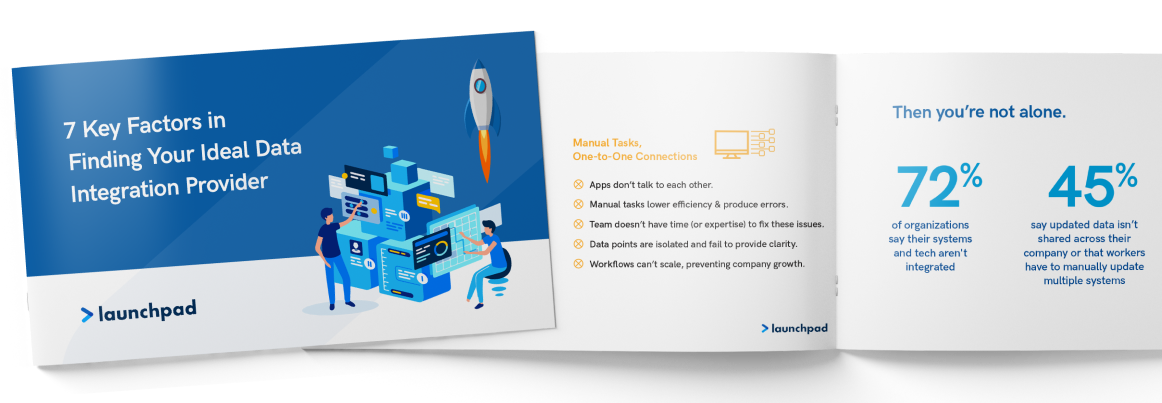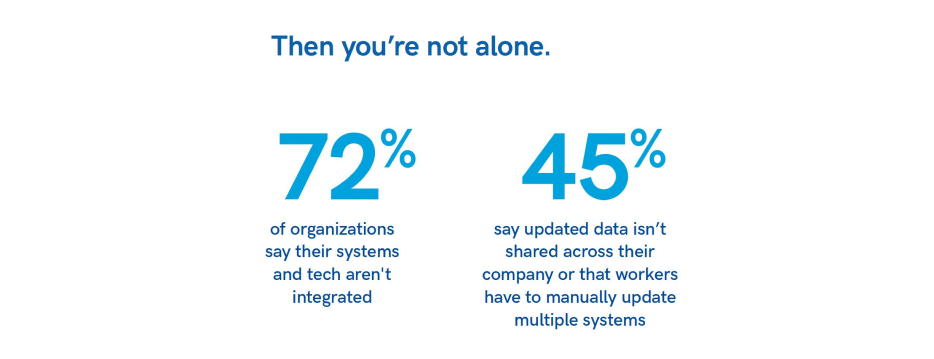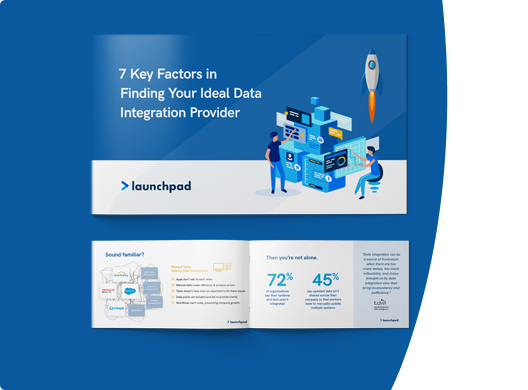Tech Decision Makers: Buyers Guide to Finding Your Ideal Data Integration Provider
Executive Summary: As a tech decision maker looking to escape data silos and disconnected apps, you need to find the ideal data integration provider. Get clarity through the 7 key decision-making factors involved.
Article
7 min read

Does this sound familiar?
Apps don’t talk together well
Data points are isolated and fail to provide clarity
Workflows that can’t scale are preventing company growth
Manual tasks are hurting efficiency and introducing errors
Your team doesn’t have the time (or expertise) to fix these issues

It's easy to see the problems that come from data silos and disconnected apps.
What’s not so easy is finding the ideal data integration provider that will make your data integration strategy possible.
"A forward-thinking data integration strategy can be the linchpin to business success."
– TDWI Research

Buyer's Guide
7 Key Factors in Finding Your Ideal Data Integration Provider
Download the free guide to explore key decision making factors to escape data silos
To help make your app integration software buying process faster and easier, we put together the Buyers Guide “7 Key Factors in Finding Your Ideal Data Integration Provider”.
The Buyers Guide covers all the essential features for an application and data integration solution that fits your growing business needs. You can learn more here.
You can also keep reading this article to get a sneak peek into some of the 7 factors covered in the Buyers Guide.
GETTING CLEAR ON YOUR DATA INTEGRATION STRATEGY
First, let’s make sure we’re on the same page about the issues you’re facing and the solutions you need.
The table below will help.
The BEFORE side lists the pain points and inefficiencies that companies inevitably face before they have integrated data management.
The AFTER side lists the benefits and outcomes that companies can realize when they have a sound data integration and automation strategy in place.
Before data integration & automation | After data integration & automation |
❌ Siloed data & systems | ✔ Internal teams easily access the data they need |
❌ Multiple apps not talking | ✔ Multiple apps connected seamlessly |
❌ Cumbersome one-to-one connections | ✔ Scalable, efficient & reusable connections |
❌ Inefficient manual tasks & data copying | ✔ Automation for data management & repeated tasks |
❌ Costly human errors | ✔ Machines reliably handling data |
❌ Inaccurate & inconsistent data | ✔ Accuracy through master data management & Single Source of Truth (SST) |
❌ Low data visibility limiting decision making | ✔ Real-time metrics monitoring, data-driven decision making & forecasting |
❌ Data isolated from vendors, supply chain, etc. | ✔ Data and systems integrated with 3rd parties |
❌ Risk of losing out to competitors that have advanced data integration | ✔ Competitive advantages of speed, accuracy & better insights |
❌ Low data security due to aging tech & out-of-date protocols | ✔ Robust data security due to next-generation tech & up-to-date protocols |
❌ Slow roll out of new data-related requests | ✔ Rapid implementation of new data-related requests |
❌ High development costs due to ad hoc connections | ✔ Reduced costs through leveraging pre-built & existing connections |
❌ Team’s time spent on developing & managing connections | ✔ Ideal data integration provider handling everything for them |
Another way to make sure we’re on the same page about the issues you’re facing and the solutions you need is with the before-and-after images below.
The BEFORE image shows a typical old-school approach to data integration that’s based on one-to-one connections. It’s costly, unscalable, and a nightmare to manage.
The AFTER image shows a modern, elegant iPaaS (Integration Platform as a Service) approach. It’s cost-effective thanks to reusing connections, it’s fully scalable, and it’s easy to manage.
BEFORE:

AFTER:

If so, then let’s examine the key decision-making factors involved with realizing your own digital transformation.
THE 7 KEY FACTORS
There are 7 key factors in finding your ideal data integration provider:

The table below provides the main question to ask for each of the 7 factors and why the answer to that question matters:
MAIN QUESTION | WHY IT MATTERS |
Do you have the budget for a data integration provider that’s only affordable to companies worth hundreds of millions or billions of dollars? | Because the faster you narrow down your list of potentials, the more time and effort you’ll save. |
Does your team have the time to take on the work that the data integration provider will leave up to you? | Because your team probably already has more than enough to do. |
Do you need your data integration up and running sooner rather than later? | Because the more time your team needs to get up to speed, the longer it will take to launch. |
Do you want dedicated monthly support and maintenance to make sure your data integration keeps running smoothly? | Because set-it-and-forget-it doesn’t apply to data integrations. |
Do you want help modifying your data integration to support the ongoing growth of your workflows and systems? | Because business growth and scaling are demanding enough on their own. |
Are you comfortable being locked into a particular data integration provider’s platform? | Because if it’s too painful to stop using a provider, you’ll remain a client even if you’d get better service elsewhere. |
Do you want it to be easy to contact a live person when you have unanswered questions? | Because as helpful as forums, FAQs and automated responses are, sometimes they’re not enough. |
But the information in the table above is just a high-level overview of what you need to be aware of when it comes to finding your ideal data integration provider.
You’ll need to dig deeper for each of the 7 key decision-making factors. To give you an idea of what that looks like, in the rest of this article we’ll explore the factors of Budget and Support in greater depth.
(Or you can find the full exploration of all 7 factors in the Buyers Guide “7 Key Factors in Finding Your Ideal Data Integration Provider” here.)KEY #1 of 7: BUDGET
MAIN QUESTION:
Do you have the budget for a data integration provider that’s only affordable to companies worth hundreds of millions or billions of dollars?
WHY THIS MATTERS:
Because the faster you narrow down your list of potentials, the more time and effort you’ll save.
It isn’t only enterprise level companies that need top quality data integration and automation to remain competitive today.
But the price tags of the big integration providers are too expensive for many medium and smaller sized companies.
You can avoid wasting your time researching providers that are out of reach by FIRST confirming they’re a good fit with your budget.
WHAT TO LOOK FOR:
A data integration provider that has the tech to handle enterprise level clients but the commitment to making their services affordable to the mass market
KEY #4 of 7: SUPPORT
MAIN QUESTION:
Do you want dedicated monthly support and maintenance to make sure your data integration keeps running smoothly?
WHY THIS MATTERS:
Because set-it-and-forget-it doesn’t apply to data integrations.
Everything changes – apps, data nodes, workflows, reporting – so your integration will need to change over time too.
Then there are platform updates and security patches that need to be managed in a timely manner.
Alerts need to be checked and addressed 24/7/365.
Problems need to be monitored and fixed…before they become major problems.
For your systems to continue being reliable, someone needs to manage these processes.
Be aware that most data integration providers don’t automatically provide dedicated monthly support and maintenance services.
WHAT TO LOOK FOR:
A data integration provider that doesn’t license you a platform that your team is left to manage on their own
An end-to-end full suite managed service – discovery, strategy, build, ongoing support, monitoring and resource management – so that your team can stay focused on their existing work
SUMMARY & NEXT STEPS
As we said, it's easy to see the problems that come from data silos and disconnected apps.
What’s not so easy is finding your ideal data integration provider that will make your data integration strategy possible.
Hopefully this high-level overview of the 7 key decision-making factors you’re facing has helped.
For the full exploration of the 7 factors and why they matter, check out the Buyers Guide “7 Key Factors in Finding Your Ideal Data Integration Provider” here.
As you continue your due diligence, remember that Launchpad’s done-for-you approach and our end-to-end managed integration service is all about:
Making things easy for our clients
No need to learn yet another platform
No downtime for your team or systems
No need to find or hire expensive developers
No need to configure your data integration or automation
Our specialists handle it all for you, faster and done right the first time
About Launchpad
We Integrate Your Apps. You Scale Freely.
We provide next-generation integration platform capabilities and custom integration services for connecting and managing enterprise automation and data integration.
Get your integration started – contact us today.
1.800.326.0188 | info@golaunchpad.io

Buyer's Guide
7 Key Factors in Finding Your Ideal Data Integration Provider
Download the free guide to explore key decision making factors to escape data silos
Try Launchpad risk-free
Transforming your integrations is easier than you think. Get started quickly with us.
- ©Launchpad 2024
- Privacy Policy
- Support